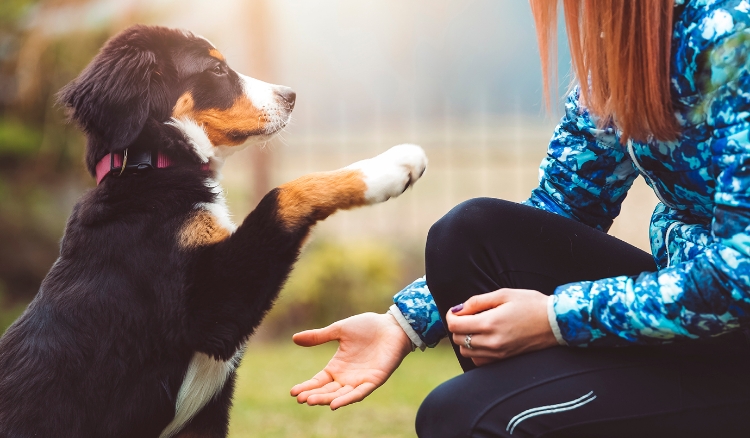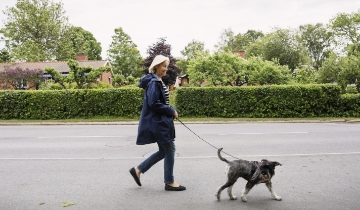Winter dog walking tips
Cooler temperatures, changeable weather and less daylight can make walking your dog in winter challenging.
How do you know if it’s too cold to walk your dog? Is it safe to exercise your dog outside in winter?
Before you go, take a look outside. If the weather looks awful (snowstorms, heavy rain, hail), it’s not a good idea to take your dog for a walk. Chances are, neither of you will enjoy it!
If it’s not safe to go outside, play indoors instead. Create an obstacle course in the living room, play tug of war or give them long-lasting tasty chews or toys they can play with.
Inclement weather aside, it is usually safe for you to take your dog for a walk during the winter in New Zealand. Some dogs, particularly larger dogs with thick coats, will enjoy long walks even if it’s cold outside. Small, short-haired dogs and dogs that are very old or very young shouldn’t spend too long outside in cold weather.
Keep an eye out for individual clues – if your dog is whining, shivering or lifting their paws a lot, they’re probably too cold and it’s time to get them warm and dry.
Top tips for winter dog-walking
- Pat down your pup with a dry towel as soon as you get home, paying attention to their legs, tummy and paws
- If the weather is awful, stay inside
- Keep walks on the short side and always use a lead
- Be cautious around deep snow – you don't know what’s in or under it
- Dress to be seen and safe (both you and your dog)
- Keep leads, harnesses and coats clean and dry, ready for your next adventure
Get prepared for winter walks
Before you go, make sure you have everything you need for a safe and fun walk.
Keep toys, harnesses, leads, coats etc. clean and dry, ready for your next adventure. This will make them last longer and will help avoid the accumulation of mould or dirt that could affect your dog’s health.
Having a mini pet first aid kit to hand is always a great idea, particularly during winter when there are more potential hazards around.
Winter also means darker mornings and evenings, so if you’re walking your dog at these times, get them a light-up collar or a hi-vis jacket. It’s important to make sure you’re both visible, especially if you walk near or will need to cross roads.
Don’t forget to keep yourself warm and safe too – a warm, waterproof coat and a pair of boots or shoes with good tread are winter dog-walking essentials.
Make sure it’s safe before letting your dog off the lead
Snow can be exciting for dogs. It’s different, it’s fresh, it’s fun! But snow can hide deep patches, frozen ponds or sharp objects like rubbish – all of which are potential hazards. Only let your dog off their lead in winter if you know it’s safe and your dog is well-trained.
Even if there’s no snow, wet weather and darker evenings will make it more difficult for your dog to find their way home if they do run off, so it’s best not to risk it.
If your dog is known to be naughty and likes to run off, it’s best to keep them on their lead.
It’s not a good idea to let your dog eat snow
A little bit of snow is generally safe for dogs to eat and snapping at snowflakes is good fun, but don’t encourage your dog to eat snow. You don’t know what’s in or is hidden by the snow. It’s not just yellow snow you need to be wary of – grit, stones or small objects can be concealed by the snow and these can be bad for your dog’s health.
Keep your dog warm
Some breeds are well-suited to cold weather (think Huskies) and probably won’t need much, if any, protection. Other breeds, particularly smaller and short-haired breeds, will be safer and more comfortable with a water-resistant coat or jumper to protect them from the elements.
If you do decide to put a coat or jumper on your dog, make sure it fits well, doesn’t restrict their movement or breathing and doesn’t rub.
Some dog owners protect their pup’s paws with booties or paw wax for an added layer of protection. Many pups can safely walk in snow or cold weather without hurting their paws, but keep a close eye on your dog. If your dog does get injured or shows signs of paw pain or distress, talk to your vet.
Wipe your dog’s paws, legs and tummy after walks
Grit, ice and dampness can irritate your dog’s skin, so clean and dry them off as soon as you get home. Pay particular attention to their paws, legs and tummy, making sure no ice or grit has accumulated.
Winter conditions can make your dog’s skin and paws tender. If you notice your dog’s paws are rough or cracked, or their skin is dry, talk to your vet. There are pet-safe moisturisers and wax available.
Finally, don’t forget to have fun! Winter brings with it new smells, sights and experiences that can be fun for your and your dog to explore together. Just because it’s cold, it doesn’t mean the adventures need to stop, especially if you follow these handy dog-walking tips.



